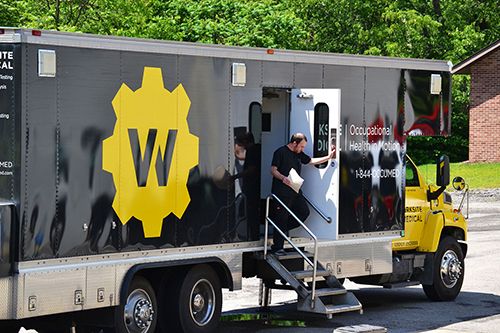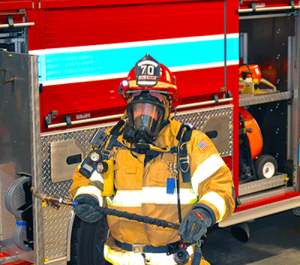Firefighters face extreme physical demands on the job. In fact, the biggest danger to these workers is not their safety, but their health.
Those demands leave firefighters susceptible to developing hypertension, diabetes, high cholesterol, and obesity. It also puts them at higher risk for both heart attacks and cancer.
According to the National Fire Protection Association (NFPA), 54 percent of firefighter deaths are caused by overexertion and stress. And last year, the Firefighter Cancer Support Network revealed that 61 percent of career firefighter line-of-duty deaths occurred as a result of cancer from 2002 to 2017.
Related: Why Cancer is the Leading Cause of Death in Firefighters
Now, more than ever before, fire chiefs and captains need to prepare their members for the job. And, that preparation must go beyond putting dousing the flames. That’s where NFPA 1582 testing becomes vital.
What is NFPA 1582?
NFPA 1582 is the standard for fire chiefs to use to ensure that their firefighters are performing at their best.
It contains a concise list of requirements for medical testing and physical examinations that should be done when firefighters join the department, and each year thereafter. The list includes items such as: a physical examination, chest x-ray, and cancer screening.
With Standard 1582’s specific guidelines, the NFPA aims to reduce risks and improve the health, safety and effectiveness of firefighters.
Broward Fire Rescue Division Chief Todd DeLuc said that learning the requirements of NFPA 1582 and implementing them at every fire station is the best way to control preventable risks. Also, it’s a way to ensure that “Everybody Goes Home.”
While the NFPA has no power to enforce the standard, some state departments, such as the Ohio Department of Public Safety, require firefighters to meet the NFPA 1582 medical requirements.
So, what exactly is involved with the exam? Let’s break it down.
NFPA 1582 Requirements – Physical Exam
The physical examination tests potential firefighters with a series of physical tests. The specific exercises are up to each department but NFPA 1582 and NFPA 1583 outline which aspects of performance need to be measured.
Aerobic Capacity
These tests measure the stress of a person’s heart rate, and how quickly they can recover after the exercise. The firefighter’s oxygen consumption is also measured. Testing procedures may include running up and down stairs, or climbing down ladders, all while wearing the standard-issue firefighter protective equipment. These specific exercises can mimic the quick burst of physical action that a firefighter may need to perform.
Body Composition
Instead of testing performance, this part of the examination will take into account body mass index (BMI), and skinfold tests. Together, these will give an accurate body composition, or ratio, of fat to muscle. NFPA 1582 also outlines a targeted workout routine with the overall goal of reduction in body fat percentage.
Grip Strength
This part of the exam will test the grip of the firefighter to see how prepared they are to carry a hose, or lift other heavy objects, during an emergency. Medical professional use a Jamar Hydraulic Hand Dynamometer to take accurate test measurements. The firefighter gets three attempts with each hand to grip the dynamometer as hard as possible.
Leg Strength
Leg strength is tested using the Jackson Strength Evaluation System. The first part of the test involves doing left lifts against heavy plates and holding for three seconds. The second part measures leg power with a jump test.
Arm Strength
This test is also measured with the Jackson Strength Evaluation System, and its performed during a specific curling exercise. The participant holds a bar in his/her hands, and bend his/her arms at a 90-degree angle. That person then must curl the bar for up to three seconds. This is measured three times repeatedly.
Muscular Endurance
The first part of this test measures push-ups for endurance. The participant must try to do as many as possible in the span of two minutes. The second part measures core stabilization with a planking challenge. If the firefighter breaks form more than three times in the set span of time, then the challenge is over.
Flexibility
This test measures flexibility in the hamstring muscles, lower back, and shoulders. Participants sit against a wall with legs and knees bent flat, and reach out toward their feet. Three attempts are allowed, with a 30-second rest in between each.
NFPA 1582 Medical Examination
The key function of the NFPA 1582 physical test is to make sure that the challenges a firefighter faces will not overexert or over-stress the participant. That makes the medical component of the test equally as important.
Synthetic materials that burn in fires contain far more toxins than ever before, thus today’s firefighters face a much higher risk than their predecessors. Medical surveillance testing was created to monitor hidden health issues, such as heart and lung function.
And, according to one Pennsylvania fire captain, early detection is a key factor of NFPA 1582 requirements.
“The testing is good because it’s a preventative measure… you can catch things early,” Neshannock Township Fire Captain Dave Congini said. “Our members are valuable and if we lose someone, either on the job or at home, it’s detrimental to the entire department.”
The following medical testing is required by NFPA 1582:
- Blood Analysis
- Urinalysis
- Pulmonary Function Test
- Chest X-Ray (Due Every 5 Years)
- EKG
- Infectious Disease Screening
- Cancer Screening
- Audiometric Exam
- Vision Testing
OSHA Respiratory Standard
As previously states, the NFPA is not an enforcer of its standard. However, OSHA does enforce its standards. Firefighters are required to wear respirators, and according to OSHA’s respiratory protection standard, they must be fit tested periodically.
Standard 1910.134 (c)(1), requires “that in any workplace where respirators are necessary to protect the health and safety of the employee, the employer must develop and implement a written respiratory protection program, which includes fit testing procedures for tight-fitting respirators.”
Stations that fail to conduct the required testing may be hit with large non-compliance fines.
Related: OSHA Cracking Down on Fire Departments After NIOSH Report
In some cases, OSHA has fined departments $1,000 per infraction. A fire department in Hartford, Connecticut faced up to $5,000 in fines after an inspector found the following violations:
- Failure to ensure that all firefighters had been fit tested for a breathing apparatus, which prevents poison gas from being inhaled.
- Failure to issue and require protective heat resistant hoods
- All firefighters did not receive required medical evaluations prior to annual fitness tests
- Failure to ensure that all breathing apparatus air cylinders were tested every five years
- Failure to ensure that firefighters wore equipment and helmets properly
Bringing it All Together
There are over one million firefighters in the United States and, over half of them serve as volunteers. Each day these brave men and women risk their lives to keep their communities safe, and it’s time to focus on doing the same for them.
To do our part with NFPA 1582 medical testing, Worksite Medical can complete all firefighter physicals and respirator fit tests at your department. We also bring the entire clinic to you, when you need it, whether it’s during one of your monthly meetings or on a weekend when everyone is available.
When you’re ready to get started, we’re ready to help. Contact us below for more information, and to receive your free NFPA 1582 guide.

Create a Less Disruptive, More Productive Occupational Health Plan with Worksite Medical!
Are you looking for a way to keep your team safe, while also limiting risk and increasing production? Simplify your medical plan today. We help team leaders like you develop less disruptive, more convenient occupational health plans that comply with complex industry standards, thus creating a healthier, more productive workforce. Take control of your medical testing program, and make sure your team is within NFPA 1582 requirements.




